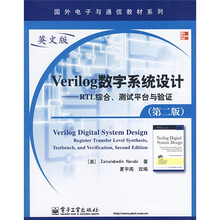Chapter 1 Digital System Design Automation with Verilog
1.1 Digital Design Flow
1.2 Verilog HDL
1.3 Summary
Problems
Suggested Reading
Chapter 2 Register Transfer Level Design with Verilog
2.1 RT Level Design
2.2 Elements of Verilog
2.3 Component Description in Verilog
2.4 Testbenches
2.5 Summary
Problems
Suggested Reading
Chapter 3 Verilog Language Concepts
3.1 Characterizing Hardware Languages
3.2 Module Basics
3.3 Verilog Simulation Model
3.4 Compiler Directives
3.5 System Tasks and Functions
3.6 Summary
Problems
Suggested Reading
Chapter 4 Combinational Circuit Description
4.1 Module Wires
4.2 Gate Level Logic
4.3 Hierarchical Structures
4.4 Describing Expressions with Assign Statements
4.5 Behavioral Combinational Descriptions
4.6 Combinational Synthesis
4.7 Summary
Problems
Suggested Reading
Chapter 5 Sequetial Circuit Description
5.1 Sequential Models
5.2 Basic Memory Components
5.3 Functional Registers
5.4 State Machine Coding
5.5 Sequential Synthesis
5.6 Summary
Problems
Suggested Reading
Chapter 6 Component Test Verification
6.1 Testbench
6.2 Testbench Techniques
6.3 Design Verification
6.4 Assertion Verification
6.5 Text Based Testbenches
6.6 Summary
Problems
Suggested Reading
Chapter 7 Detailed Modeling
7.1 Switch Level Modeling
7.2 Strength Modeling
7.3 Summary
Problems
Suggested Reading
Chapter 8 RT Level Design and Test
8.1 Sequential Multiplier
8.2 von Neumann Computer Model
8.3 CPU Design and Test
8.4 Summary
Problems
Suggested Reading
Appendix A List of Keywords
Appendix B Frequently Used Syetem Taske and Functions
Appendix C Compiler Directives
Appendix D Verilog Formal Syntax Definition
Appendix E Verilog Assertion Monitors

 缺书网
缺书网 扫码进群
扫码进群





